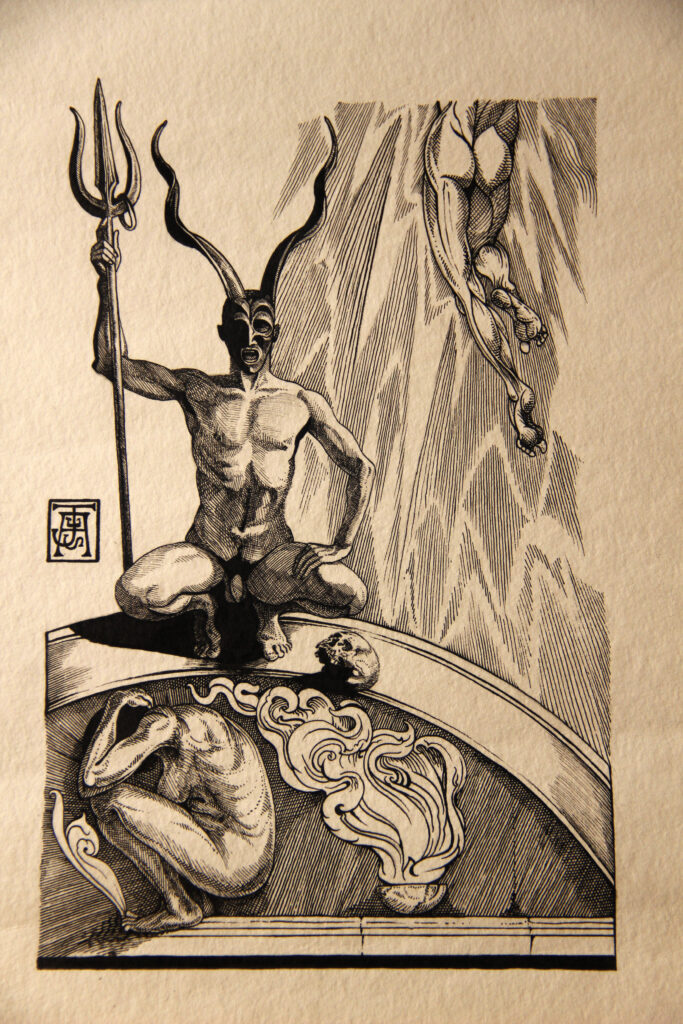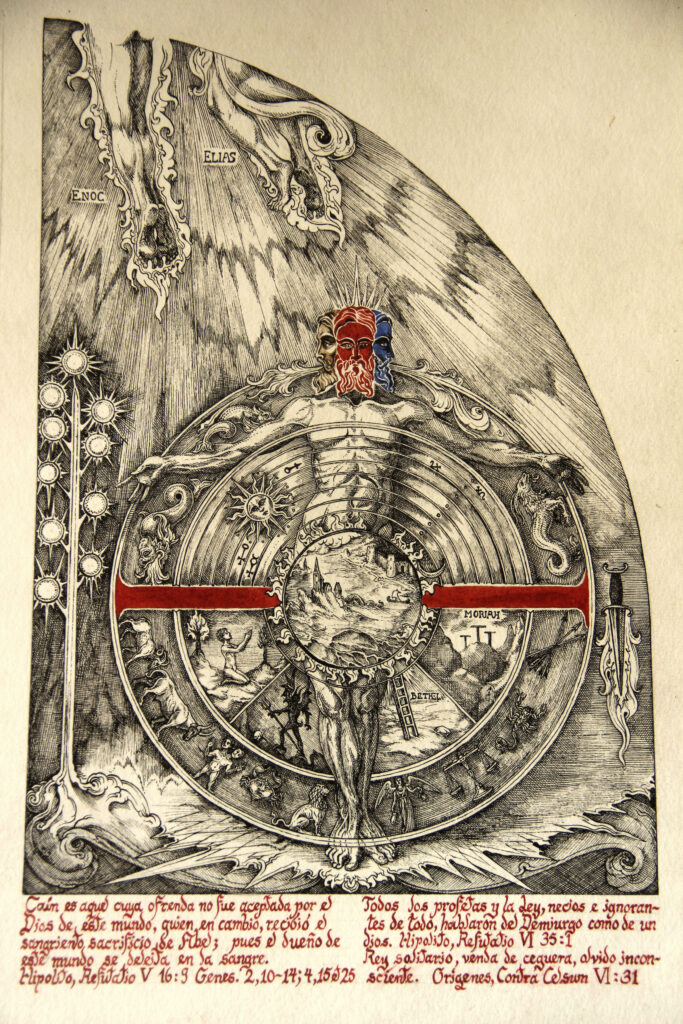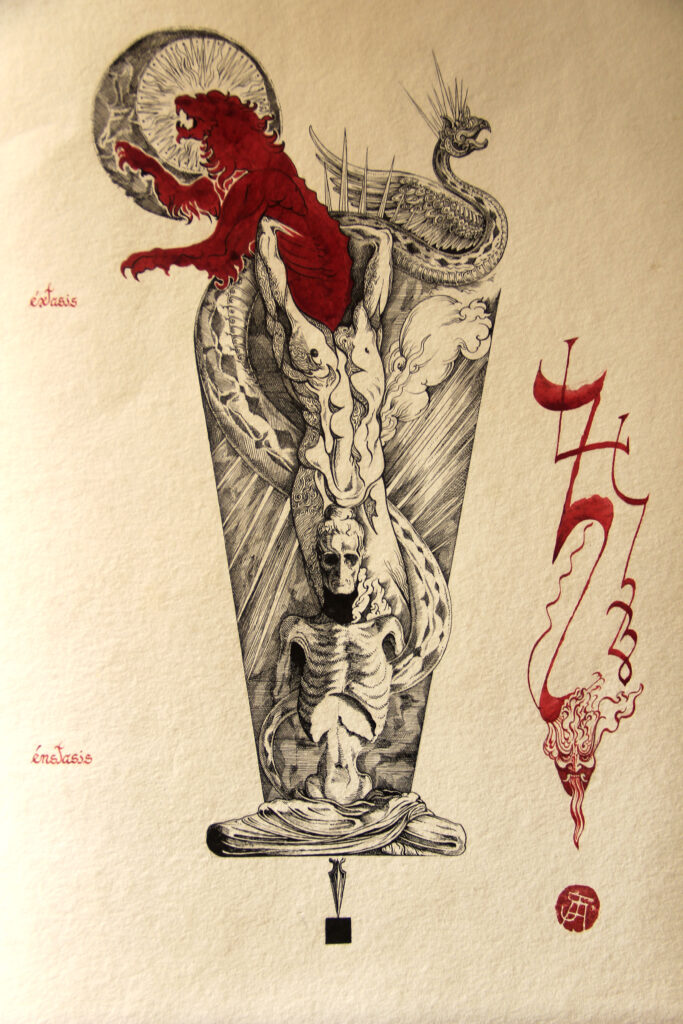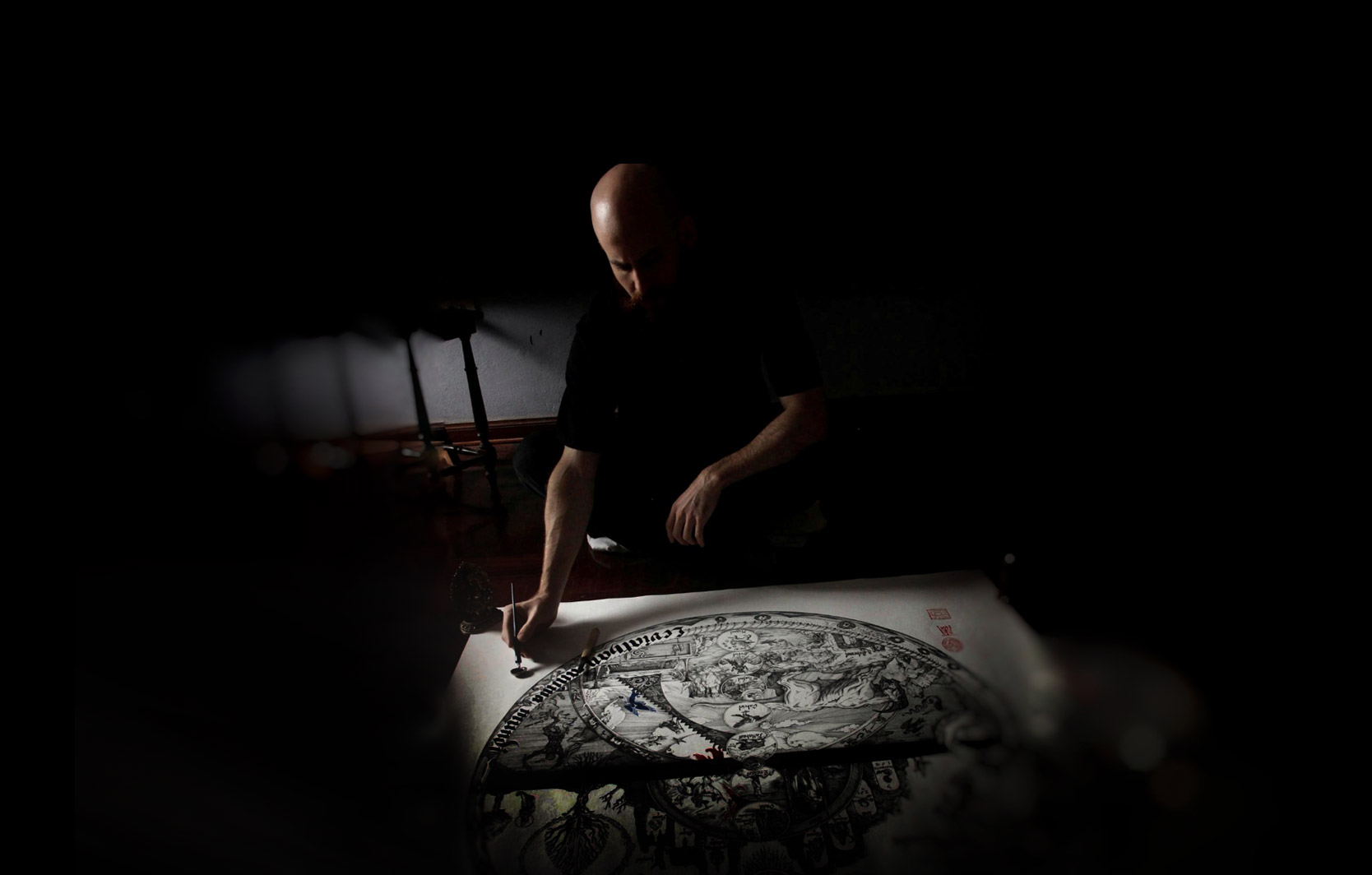A short talk with Jose Gabriel Alegria Sabogal about his education, line technique illustrations and publications, involvement in the black metal scene, the Occulture Esoteric Conference and more.
- ꜜ Inception ꜜ Academics ꜜ Methodology ꜜ Publications;ꜜ Sound;ꜜ Inwardness
I
Inception
How did this passion for drawing and illustration commence, and what pushed Jose Gabriel Alegria Sabogal to follow such an affection to become a career later on?
I never stopped drawing, as all children do. This is why I believe in practice before talent. Drawing became the language where I felt confident and could keep building with time. It must have been when I was around 13 that I came across a book with Durer’s engravings, and I decided to start copying them all, which became the basis of my training.
What inspired you to continue expressing your artistic self in that direction, and not in different ways?
I have always been a creature of habit, and an interesting thing is that by now my drawings have been reproduced in all media, without me having to change my technique. I share Vasari’s belief that drawing is the root of all different art forms, as it stands closer to the idea. If one thing I would do is to make my materials even simpler.
II
Academics
Jose Gabriel Alegria Sabogal was educated in painting at the Pontifical Catholic University of Perú and the Universitat de Barcelona, and is currently working on doctoral research at Stony Brook University, NY. How did all of this come together until it has now reached a soon-to-be PhD?
I transitioned indeed from an artist to an academic education-wise. It was during the pandemic that I decided to try my luck at a PhD, after already having a Master’s in Art History, and I could do so because I qualified for a full scholarship. Although this meant a great sacrifice in my capacity to produce artwork, it all came about because I firmly believe that artists must educate themselves and find ways out of what is often a very precarious market. And I thought the best way to go about this is to lead by example, instead of demanding it from others.
A follow-up question hints at considering teaching; is this something Jose Gabriel Alegria Sabogal is planning to pursue after acquiring the PhD, possibly spreading the knowledge to younger art enthusiast calibres?
I have not decided anything yet in that regard. For now, I think it is almost my duty to become an artist full-time again. If I did teach, I would probably choose to teach Art History only, for I don’t know if I even can teach other artists how to find their way, as there is no rule for that.
Your research interests include religious iconography and Sanskrit philology, the comparative study of religion, and Gnosticism in particular; in what ways do these interests connect to Jose Gabriel Alegria Sabogal?
I think they are all deeply connected. Drawing has a mnemonic purpose, and I think it reflects one’s own learning, memory and aspirations, therefore, my studies are directly reflected in what I create.
III
Methodology
Specialized in the line technique illustration methodology, what makes this technique special and what obstacles did Jose Gabriel Alegria Sabogal face while developing his own illustration school?
Many of the fundamental sources for Western esotericism were printed in this technique, and therefore my drawing dialogues with such tradition. However, the process with copper plates and acid etching requires a large workshop. As my life became increasingly nomadic, I therefore became more of a draftsman, and I prioritise mediums that are portable and simple yet allow for sophistication in trained hands.



How does the Renaissance copper plate engraving inspire Jose Gabriel Alegria Sabogal‘s line technique, and what is unique about this method compared to other engraving methods?
Copper plate engraving is sharper and allows for finer lines than almost any other engraving technique. To me, it was fundamental to do it on copper first, in order to understand how the lines operate on it. Ink has other possibilities, especially when it comes to calligraphy, so I try to combine both the aspects of printed media and manuscripts in my own hybrid.
IV
Publications
Jose Gabriel Alegria Sabogal has participated as an author and illustrator in a handful of publications under different publishing houses such as Anathema Publishing, Scarlet Imprint, Mount Abraxas and Aeon Sophia Press; can you walk us through the process from idea to reality?
It changes from one book to the other. With Aeon Sophia Press and Anathema, I have published material that is entirely my own, yet the challenges of putting a book together require a great deal of organisation that most artists are not trained for. There is no rule of thumb, and one has to learn by doing so-to speak.
In cases like (h)Aurorae by Gabriel McCaughry, I received the poems and was allowed to develop the visual concepts entirely from that at my discretion. With Scarlet Imprint, we have published illustrated versions of Frater Acher’s Holy Daimon cycle. And in this case, sometimes Acher had specific images in mind, other I was given the text and allowed to illustrate on my initiative.
The occult, magic, spirituality, the esoteric and of course history are the dominating subjects of your publications, either as an author, co-author or even illustrator; how has your participation in publishing changed Jose Gabriel Alegria Sabogal‘s artistic view, and vice-versa?
In a sense, it limits the formats to what can be published, and one learns the technical requirements of making a book. Nothing can be more frustrating than spending months on a piece that will not be fully visible once in a book. On the other hand, publishing teaches one to organise broader and more comprehensive projects as an artist instead of thinking about every artwork as an isolated thing.
You held a talk where you provided insight into the reconstruction of the Gnostic imagery process at the Occulture Esoteric Conference that took place in Berlin in 2022; and your IAO: Ophite Iconography book was a part of the talk; tell us more about this experience and its impact on you.
Certainly, these gems have constituted a deep fascination for me, as an endless source of imagery that has remained understudied. They also provide an enormous corpus for learning and cataloguing in what one may call the “antiquarian mind”. I started with the hope that they would constitute sources for the study of Gnosticism, yet studies like that of Campbell Bonner (Bonner, Campbell).
Studies in Magical Amulets, chiefly Graeco-Egyptian. Ann-Harbor, University of Michigan Studies, 1950.) have posited that they not always do, and that the panorama of late antique religions was much more chaotic and mixed. As such, they attest to magical beliefs and practices more than they do to specific doctrines. This, however, doesn’t make them less interesting to me.
V
Sound
Jose Gabriel Alegria Sabogal has a hand in working with several bands in the black metal genre; such as Whoredom Rife, Mephorash perhaps among others; are you a black metal fan or a metal fan from the start? And how do you view the correlation between your art and symbolism in music, and possibly to black metal?
I was an intense black metal fan in my teens, and slowly gravitated away from it as I became focused solely on my readings. However, black metal came back for me, as I was increasingly asked to illustrate for more projects. Although the genre is occult-themed, I don’t think it always actually engages with the sources, and it doesn’t always have to. Moreover, for me, it worked as a gateway for my interests, and I think it does for many people.
What music are you into? And how does sound impact your state of being while illustrating or working on a project, or a publication?
I am, in fact, passionate about early baroque music, and I enjoy playing and studying it on the piano (Couperin, Rameau). I do not consume a great deal of black metal at this stage of my life, yet I do enjoy listening to the projects I work for as an artist and try to capture their feeling on a more visceral level.
VI
Inwardness
With such a background, knowledge and art experience, what is Jose Gabriel Alegria Sabogal’s take on spirituality and the occult?
The occult/esoteric implies direct ways of experiencing the divine, and in this sense, it is extremely dangerous. I do not feel entitled to tell anyone how to go about it, and I never share direct experiences of it. I want to believe that my artwork does. Instead, I try to be transparent with the sources I am passionate about, mostly from the Renaissance, and try to motivate people to go back to them, study and enjoy.
How did the evolution of consciousness impact who José Gabriel Alegría Sabogal is throughout his journey so far?
Interesting broad question. I feel my general attraction towards apocalyptic themes has been highly confirmed in these last years as we regress towards medieval calamities like plague and war. But I believe time is cyclical and knowledge is the absolute good.

